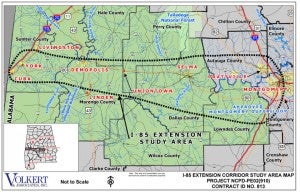Hearings set for interstate expansion
Published 3:30 pm Monday, July 19, 2010
From Staff Reports
A series of public meetings will be held this week regarding the proposed extension of Interstate 85 westward from Montgomery.
Meetings will be held at the Coleman Center for the Arts at 630 Avenue A in York on Monday from 5-7 p.m.; at the Demopolis Civic Center on Tuesday from 5-7 p.m.; at the Carl C. Washington Jr. Civic Center at 211 Washington St. in Selma on Wednesday from 5-7 p.m.; and at Southlawn Middle School at 5333 Mobile Highway (U.S. Highway 31) in Montgomery on Thursday from 5-7 p.m.
All of the meetings are open to the public. Volkert Engineering, the Alabama Department of Transportation and the Federal Highway Administration will be present.
“The purpose is to highlight the draft environmental impact study conducted for the potential extension of I-85 to connect with I-59 and I-20 at the Mississippi state line,” said Ed Martin, a spokesman for the team. “The results are eye-popping.”
There is also a Web site for people to gain information about the project, www.I85extension.com.
The draft environmental impact statement evaluates the potential social, economic and environmental effects of the project. The study includes large parts of six Black Belt counties, including Dallas, Hale, Lowndes, Marengo, Perry and Sumter, and portions of Autauga and Montgomery counties.
The University of Alabama Center for Business and Economic Research conducted a socio-economic analyses for the proposed project, which indicate all eight counties within the project study area are projected to experience an increase in population with the construction of the proposed project, except for Sumter County, according to an overview of the impact study.
“Employment forecasts indicate that the counties within the project study area will see an increase in jobs,” the study states. “Economic output forecasts project that each county within the project study area will increase its output. It is anticipated that growth in many of the region’s counties will be in labor intensive industries, such as trade and services.”
However, individuals should not expect to see construction soon. The project is in the planning phases, with estimated costs ranging from about $2.1 to $2.5 billion. The preferred route would cost about $2.4 billion.
Leesha Faulkner and David Snow contributed to this report.






